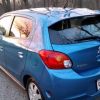Hi guys, I don't post much, but since my Mirage ES 5spd is a January 2018 purchase there's not too much to say for me.
Specs:
2018 Mirage ES 5spd hatch, 19k miles.
Oil is quite new, less than 500 miles on it.
Issue:
I drove my Mirage about 15 miles on the 7th, at around 8pm, mostly highway, made a pitstop at a grocery store and the finished my trip.
The temperature dropped to 28f/-2.2c, and it snowed a little bit.
the car sat parked until today, the 8th, until I started the car around 2pm, temperature around 38f/3.3c.
Total sitting time, 18 hours (car has sat longer than that in the past before with no issues).
1st start attempt:
I turned the key and the car half halfheartedly started and immediately quit after I let go of the key, on it's own (it didn't even idle, just died immediately).
2nd start attempt :
I turned the key and the car cranked for a solid 20 seconds with no indication that it would start, it just cranked and cranked.
I applied a little bit of throttle and the car started very slowly, barely running, I pushed the throttle until it smoothed out, and I cautiously let go and the engine almost immediately died again.
As it almost stuttered to a stop I pushed the throttle up to 2,000 RPM and kept it there for about a minute, when I let go of the throttle the car idled at 1,500 RPM (for reference my car has never idled higher than 1,100-1,200 RPM when cold started, EVER)
I immediately started driving not trusting the car and got on the highway and drove about another 15 miles back, for the rest of the day the car ran and idled normally with no issues. I did notice that it seemed a little down on power, though that may have been in my head.
Has anyone else had cold start issues like this?
I have been running my car almost exclusively on 93 octane since I got it, and the recently I filled up 3/4s of the tank with regular because I was a bit short on cash. I figured these cars are rated for regular gas/87 octane that it wouldn't hurt anything but now I am suspicious, I filled up at a place I don't normally get fuel, though I am not convinced it was necessarily the fuel, I only add that info to try give as complete a picture as I can.
I've driven the car and started it in much colder weather than this, and never noticed a performance drop, so I am baffled by this.
Are there any common issues that could cause this?
Again, 19k miles on the clock.
I am hoping against hope this doesn't happen again, but I'd be lying if I said this didn't shake my faith a bit in the reliability of this car.
Thanks guys!


 Mitsy
Mitsy
 Reply With Quote
Reply With Quote
 Underdog
Underdog My Mirage
My Mirage

 "Scarlett and Marsha"
"Scarlett and Marsha"
 Speck
Speck
 2017 Mitsubishi Mirage ES Plus
2017 Mitsubishi Mirage ES Plus